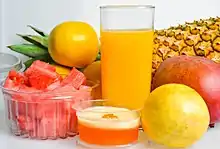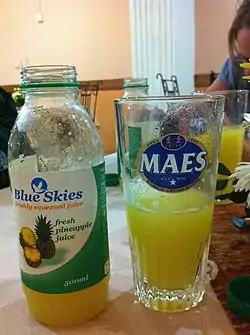鳳梨汁
生产
| 每100 g(3.5 oz)食物營養值 | |
|---|---|
251 kJ(60 kcal) | |
15.7 g | |
| 糖 | 14.45 g |
| 膳食纖維 | 0.8 g |
0.08 g | |
0.42 g | |
| 维生素 | |
| 硫胺(維生素B1) | (9%) 0.1 mg |
| 核黃素(維生素B2) | (2%) 0.02 mg |
| 菸鹼酸(維生素B3) | (2%) 0.28 mg |
(2%) 0.1 mg | |
| 吡哆醇(維生素B6) | (5%) 0.07 mg |
| 葉酸(維生素B9) | (1%) 5 μg |
| 胆碱 | (1%) 4.8 mg |
| 维生素C | (11%) 9.5 mg |
| 膳食礦物質 | |
| 鈣 | (1%) 14 mg |
| 鐵 | (2%) 0.28 mg |
| 鎂 | (4%) 14 mg |
| 錳 | (53%) 1.12 mg |
| 磷 | (1%) 6 mg |
| 鉀 | (3%) 122 mg |
| 鈉 | (0%) 1 mg |
| 鋅 | (1%) 0.10 mg |
| 其他成分 | |
| 水 | 83.5 g |
| Link to USDA Database entry 參照美國標準的相對百分比 成人每日的参考膳食摄入量(DRI) | |
黄梨汁是由成熟的黄梨制成的。[1][2]在榨汁前要清洗黄梨,使用刷子和喷雾清洁机去除污渍、瑕疵和农药残留。[3]清洗干净后,将黄梨放入黄梨去皮榨汁机中,获得果肉,再放入螺旋榨汁机中。[3]然后,使用果汁精细过滤器去除黄梨汁中的所有固体、纤维和胶体颗粒。[1][3]
黄梨汁粉末是由黄梨汁喷雾干燥于木薯根淀粉的麦芽糊精上并使其干燥而成的。[4]
市场
2016年,欧盟消费了50%的黄梨汁。[5]荷兰是2016年欧洲最大的菠萝汁进口商。[5]泰国和哥斯达黎加则是2016年欧盟市场的主要供应国。[5]2017年,黄梨汁消费量最多的国家是泰国、印度尼西亚和菲律宾,合计消费量占世界总量的47%。 [6]与它们的人口相比,中国和印度的黄梨汁消费量较低。[6]
参考资料
- JF Morton. . NewCROP, New Crop Resource Online Program, Center for New Crops and Plant Products, Department of Horticulture and Landscape Architecture, Purdue University. 1987 [10 June 2019]. (原始内容存档于2020-02-11).
- Pineapple juice processing complete sets of production lines (页面存档备份,存于) TICO, Retrieved June 10, 2019
- Pineapple juice processing line (页面存档备份,存于) TICO, Retrieved June 10, 2019
- Pineapple Juice Powder (页面存档备份,存于) Spices, Inc. Retrieved June 12, 2019
- . Centre for the Promotion of Imports, Ministry of Foreign Affairs, Government of the Netherlands. 13 December 2017 [12 June 2019]. (原始内容存档于2020-05-09).
- . AgriOrbit. 21 January 2019 [22 May 2019]. (原始内容存档于2020-05-27).
- Tom Hunt. . The Guardian. [11 June 2019]. (原始内容存档于2019-09-04).
- The "Strained Pineapple"....History of Pina Colada (页面存档备份,存于) Piteliaxitelia Retrieved June 11, 2019
扩展阅读
- Carneiro, Lucia; Dos Santos Sa, Iralla; Dos Santos Gomes, Flávia; Matta, Virginia Martins; Cabral, Lourdes Maria Corrêa. . Desalination. September 10, 2002, 148 (1–3): 93–98. ISSN 0011-9164. doi:10.1016/S0011-9164(02)00659-8.
- Sreenath, Hassan K.; Sudarshanakrishna, Kadambi R.; Santhanam, Krishnaswamy. . Journal of Fermentation and Bioengineering. December 1, 1993, 78 (6): 486–488. ISSN 0922-338X. doi:10.1016/0922-338X(94)90054-X.
- Braddock, R.J.; Marcy, J.E. . Journal of Food Science (Wiley). 1985, 50 (6): 1636–1639. ISSN 0022-1147. doi:10.1111/j.1365-2621.1985.tb10552.x.
外部链接
 维基共享资源上的相關多媒體資源:鳳梨汁
维基共享资源上的相關多媒體資源:鳳梨汁- Dole's Pineapple Juice (页面存档备份,存于) Hawai'i Digital Newspaper
This article is issued from Wikipedia. The text is licensed under Creative Commons - Attribution - Sharealike. Additional terms may apply for the media files.

